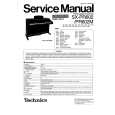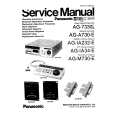|
|
|
Kategorie
|
|
Informacje
|
|
Polecamy
|
|
|
 |
|
|
Dla tego produktu nie napisano jeszcze recenzji!
 ;
Bardzo dobra instrukcja. Zawiera wszystko co potrzeba, polecam!
 ;
Instrukcja jest OK. Schematy czytelne, opisane niektóre procedury.
 ;
Instrukcja bardzo czytelna. zawiera co potrzeba. Polecam
 ;
...instrukcja serwisowa w pełni czytelna i kompletna. Dziękuję!
 ;
Instrukcja Serwisowa jest kompletna i czytelna. Dziękuję!
SYSTEM SETUP
� Progressive: Select this option if you have a video display that is compatible with input sources of 480p or greater. Displays labeled as �HDTV Ready,� including virtually all large-screen LCD and plasma displays, are compatible with progressive scan. � Interlaced: Select this option when you are using an older video display that has Y/Pr/Pb component inputs, but which is not capable of displaying high scan rate, or �HD,� signals. Video Mode: This setting affects only the Component Video Outputs �, and it controls how the video signals are optimized for progressive scan display. In most cases, the �automatic� mode is your best choice, as it senses whether the disc being played was originally recorded on video or shot on film. However, in some cases you may wish to compensate for errors in the disc authoring that occur when the frame rate is not properly maintained when films are converted to video. Three choices are available: � Auto: This is the recommended setting, as it lets the HS 100 analyze the signals from the DVD and adjust the output accordingly. � Movie: Choose this option for optimal playback of material that was shot on film, even though you are viewing it on video via a DVD. � Video: Choose this option for optimal playback of material that was shot directly to video, such as concerts and sports programming. � The proper color transition, seen as sharp separation of the bars. � The performance of the color circuits in your TV (with �Video� signals); bar edges should show no vertical crawling dots. With the gray scale and the black/white fields below the color bars, the brightness and contrast of your screen can be adjusted. When you press Enter z the video adjustments will appear inside a black bar at the top of the screen, with either the video from a disc being played or the splash screen shown on the rest of the screen.
To change any of the video adjustments shown at the top of the screen, first press the M / N /K/L Navigation Buttons k so that the �+� to the right of a parameter name is highlighted to increase the setting or ��� to the right of a parameter name is highlighted to decrease the setting. Then press the Enter Button z to change the value as shown by the number of blue lines to the left or right of the center line. When only the dark center line is shown with no blue lines, the setting is at the midpoint default value. When adjusting the Black Level setting, note that the adjustment available is to either have the setting at the midpoint, which provides a full �0 to 100� black level setting, or �full,� which complies with standards for video with what is called �setup,� or a �7.5 to 100� black level setting. Changes to any of the settings may be made with a test disc playing, or you may use the internal test signal by pressing the M / N /K/L Navigation Buttons k until the word OFF is highlighted next to the TEST SCREEN line. To activate the test signal, press the Enter Button z and note that a special combination test signal, including both color bars and gray scale along with 100% black and white fields, will be displayed. To recall the video controls, press the OSD Button y and then navigate among the settings and make any necessary changes following the steps in the previous paragraph. Test Screen With the test screen showing on your video display, the following adjustments may be made: � The proper color intensity setting on your TV. � Proper color adjustments using the color bars, which should be (left to right) black, white, yellow, cyan (turquoise), green, magenta, red, blue, black.
TV Picture Adjustment With Test Screen
Brightness Adjustment: 1. Turn down the color control on your TV until the color bars are visible in black and white. 2. Adjust the contrast to the lowest level where you still can see all bars within the gray scale in the test picture separately and clearly. 3. Adjust the brightness so that the bars in the gray scale are all visible. The bar furthest to the left has to be as black as possible rather than gray but the next gradation must clearly be distinct from it. All the bars in the gray scale should be gradually and evenly changing from black to white, left to right. Contrast Adjustment: 1. Adjust the contrast on your TV until you see a bright white bar in the lower right corner of the screen and a deep-dark-black bar to the left. The optimal contrast setting will depend on your preference and the surrounding light in the TV room. 2. If the brightness of the white bar no longer increases when the contrast is turned up or the borders of the white �harman/kardon� letters on top bloom (overlight) into the black areas (drastically decreasing the sharpness of the type), the contrast has been turned up too much. Reduce the contrast until these effects disappear and the video still looks realistic. 3. If you are watching TV with customary surrounding daylight, adjust the contrast so that a normal video picture has about the same look as the surroundings in your room. That way the eye is relaxed when watching the TV picture. This contrast setting may be reduced when the surrounding light is dimmed, thereby usually improving the sharpness of a video significantly. 4. The gray scale in the middle line needs to have the same clear difference between each bar as
Video Adjustments Menu
This menu allows you to adjust five key parameters of the video signal to compensate for differences between HS 100 and other video sources. You may use either the HS 100�s built-in color bar test signal or a test disc as the standard for the adjustments. To ensure that your system is properly optimized, we strongly recommend that you adjust your video display using the display�s own controls before making any changes to the HS 100�s output. Once the display is properly calibrated with all settings on the HS 100 set to their midpoint, use the controls on this menu to finetune the HS 100�s output. Due to the nature of these settings, the navigation is somewhat different from the HS 100�s other menus and controls. The menu itself is called up in the same way as the other menus. Press the OSD Button y to activate the main menu screen, and then press the K/L Navigation Buttons k so that SETUP is highlighted. Press the Enter Button z, and then use the M / N /K/L Navigation Buttons k until the VIDEO ADJUSTMENTS menu box (which contains an icon with slider controls and the word VIDEO, and is located at the bottom of the column in the Submenus Area �) is highlighted within a white outline. Then press Enter z again.
17
SYSTEM SETUP
15
|
|
 |
> |
|


































